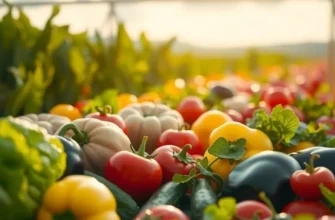Steaming is one of the healthiest cooking methods, preserving vibrant colors, flavors, and nutrients in vegetables. Perfectly steamed vegetables can be the star of any meal, whether you’re an experienced chef or just starting. This guide offers practical tips to help you steam veggies to perfection, making you a more confident cook in no time.
Choosing the Right Vegetables for Steaming

Selecting the perfect vegetables for steaming begins with a keen eye for freshness. Fresh vegetables retain more nutrients and have a superior flavor. Look for vibrant colors, firm textures, and avoid any visible bruising or wilting. Farmers markets and local produce stands are excellent sources, as they often offer freshly picked options.
Size plays a crucial role in the steaming process. Uniformity ensures even cooking, preventing some pieces from being undercooked while others are overdone. Aim to cut vegetables into consistent sizes. For example, slice carrots into coins or sticks of the same thickness. Similarly, broccoli florets should be comparable in size to cook evenly.
Variety not only adds visual appeal to your dish but also enhances the nutritional profile. A mix of leafy greens like spinach, cruciferous options such as cauliflower, and colorful choices like bell peppers can brighten up your plate. Each vegetable brings a unique set of vitamins and antioxidants, contributing to a balanced diet.
When considering different vegetables for steaming, prioritize those that retain their texture and enhance flavor once cooked. Vegetables like asparagus and green beans hold up well during steaming, maintaining their crispness. On the other hand, root vegetables such as potatoes or sweet potatoes might require cutting into smaller pieces to ensure thorough cooking.
For an eco-friendly approach, consider utilizing seasonal produce. Seasonal vegetables are often fresher, cheaper, and have a lesser environmental impact due to reduced transportation needs. This ties in with concepts from sustainable kitchen practices, promoting smarter choices in vegetable selection as discussed here.
Experimenting with different vegetable combinations can also introduce new flavors to your meals. Pairing stronger flavored vegetables like brussels sprouts with milder ones like zucchini can balance and complement each other. Steaming not only preserves the intrinsic flavors of these vegetables but also allows for seasoning with herbs and spices post-cooking to suit personal preferences.
In summary, the key to mastering perfectly steamed vegetables starts with selecting the freshest, most vibrant options. Consider uniform size for even cooking, and aim for a colorful variety to maximize both nutrition and flavor. Embrace seasonal choices for an eco-friendly kitchen, ensuring each meal is both delicious and responsibly sourced.
Steaming Techniques for Maximum Flavor and Nutrition

Steaming vegetables is a culinary art that, when mastered, can bring out the best in each ingredient. Unlike boiling, steaming uses the power of steam heat to cook vegetables gently, ensuring that their vibrant colors and textures are preserved. To elevate your vegetable steaming skills, let’s delve into the key techniques that can help you achieve maximum flavor and nutrition.
Begin by selecting the right tool. Traditional steamers, bamboo baskets, and metal inserts are all excellent choices. Each offers a unique advantage. Bamboo steamers, for example, impart a subtle aromatic quality to the vegetables, while metal inserts fit snugly into pots for minimal steam escape. Whichever tool you choose, ensure it allows steam to circulate freely around the vegetables for even cooking.
Water management is crucial. Fill your steaming apparatus with just enough water to create ample steam without submerging the vegetables. The water should be at a rolling boil before introducing the vegetables. This ensures that they start cooking immediately without soaking, which can lead to nutrient loss.
Timing is essential; overcooking can turn vibrant veggies into mush and rob them of valuable nutrients. Thinly sliced carrots may only require about three to four minutes, while denser vegetables like broccoli could take five to seven minutes. Consider using a timer to avoid going over the desired doneness.
A more advanced technique is tiered steaming, where you cook a variety of vegetables simultaneously by arranging them in layers. Place dense vegetables at the bottom and delicate ones on top. This technique not only saves time but also ensures that each vegetable type reaches perfect doneness. Done right, all the vegetables emerge from the steamer vibrant and flavorful.
For added flavor, consider infusing the steaming water with herbs or spices. Infusing water with ingredients like bay leaves or even a slice of ginger can subtly enhance the taste of the vegetables as they steam. This technique requires no additional salt, in line with our guide on flavor boosters without salt.
After steaming, allow the vegetables to rest momentarily. This lets any residual moisture evaporate, ensuring the veggies are not watery when served. Season lightly after steaming to maintain the vegetable’s natural flavor integrity. A drizzle of olive oil, a spritz of lemon juice, or a sprinkle of fresh herbs can truly elevate steamed vegetables.
Finally, to make the process more efficient, always prep your vegetables of similar size. Uniformity in size ensures that each piece of vegetable cooks evenly. Invest a little time in preparation, as this step is crucial for achieving consistent results.
Mastering these steaming techniques will allow you to consistently serve vegetables that are not only beautiful to look at but brimming with nutrition and flavor. With practice, these methods will become second nature, providing a base for countless healthy and delightful meals.
Final words
Perfectly steamed vegetables can be achieved through careful selection and proper cooking techniques. The vibrant colors, flavors, and nutrients will impress your family and friends, making any meal more appealing and nutritious. Remember, the key is to choose fresh produce and keep an eye on cooking times. With practice, steaming will become a quick, easy, and rewarding skill in your kitchen arsenal. Embrace this cooking method, and enjoy the delightful results!







